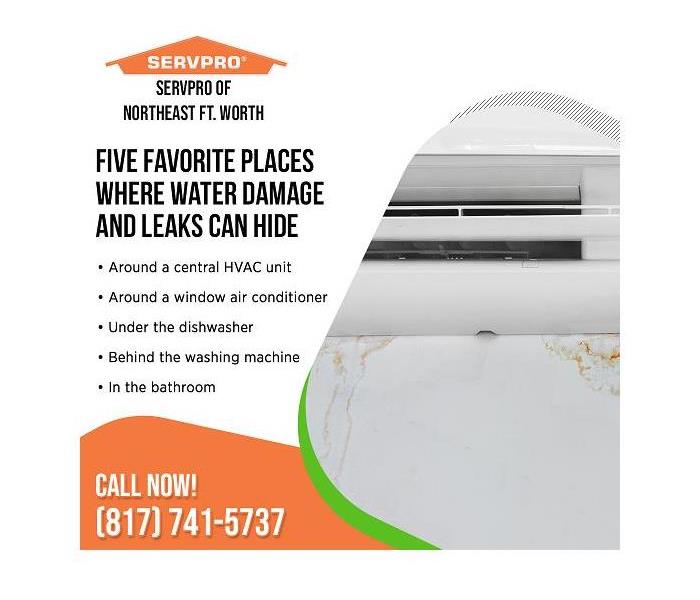Five Places Where Hidden Water Leaks Are Quietly Causing Water Damage
11/1/2021 (Permalink)
Blog Summary: When hidden leaks cause extensive water damage, homeowners can turn to SERVPRO of Northeast Fort Worth, a local leader in water damage restoration.
Locally owned and operated, SERVPRO of Northeast Fort Worth is a leader in water damage restoration in Halcolm City, TX, and the surrounding areas. The team of technicians serves the Fort Worth area with integrity and the highest professional standards.
Continuous or repeated exposure to water and moisture can damage subflooring, plywood sheathing, wood studs, and insulation. The fact that this water damage often plays hide and seek makes the situation even worse. Here are five favorite places where water damage and leaks can hide.
#1. Around a central HVAC unit
An HVAC system produces condensation on the indoor evaporation coils. The moisture, anywhere from five to twenty gallons depending on the humidity level, is collected in a shallow condensate pan and evacuated through a drain line to the outside of the home. If the line clogs, the pan will overflow. The inside portion of an HVAC system is often tucked away in the attic or closet, where the leak can go hidden for months. Inspect the inside evaporator coils and condensate pan when changing the filter. This proactive approach will enable homeowners to detect most leaks before a serious water damage issue arises. An annual inspection of the HVAC system by a certified technician should be on everyone’s spring cleaning list.
#2. Around a window air conditioner
As a window AC unit cools a room, moisture from the coils is directed to the exterior portion of the unit where it is discharged. If the evacuation tubing fails due to clogs, rot, or rust, the water will escape and drain into the wall space below the unit. Wood rot and a potential mold infestation can result. Feel for wet sheetrock or spongy flooring beneath the appliance, and be on the alert for a moldy, musty smell. The unit may need to have its filter and coils cleaned.
#3. Under the dishwasher
To keep water from seeping out of the tub, dishwashers have a watertight seal. However, leaks can develop in the joints of the dishwasher’s water supply line or in the drain line. Because the flooring underneath the dishwasher cannot be easily seen, a slow leak can cause widespread damage to the subfloor over time. The homeowner might not discover the damage until it is time to move or replace the dishwasher.
#4. Behind the washing machine
Tucked away in the laundry room, the washer can conceal leaks at the water supply line connections. Make a habit of inspecting the connections. Proactively replace the lines about every five to seven years to prevent a major water intrusion. Watch out for water pooling around the base of the appliance. When a leak does occur, resolve it immediately to prevent secondary advanced water damage.
#5. In the bathroom
The bathroom, the wettest room in the home, is a favorite hiding place for water damage and leaks. The normal use of the shower, tub, toilet, and sink yields sufficient moisture to foster a mold infestation. Several places where water damage and water leaks lurk include:
Under the vanity sink
A slow drip from a supply line or the drain under a bathroom (or kitchen) sink may hide out until the homeowner is alerted by a musty smell or spongy flooring. Limited or no ventilation, darkness, and moisture from the leak make the area under the sink a prime spot for a mold infestation.
Next to the shower or tub
The shower and tub have several water line connections, and each connection provides an opportunity for a leak. Since these connections are often concealed within a wall, any leaks are also hidden behind the wall. Water damage from the leak signals the homeowner to a problem. Warped drywall, peeling paint, blistering wallpaper, a spongy floor, and a musty smell give away the hiding place.
Under an unstable toilet
The wax ring between the toilet base and the toilet flange may develop a leak. Sometimes a pool of water around the base of the toilet hints at a problem. This type of leak usually goes undetected until the subflooring rots, allowing the toilet to wobble. In some cases, the toilet may fall through the floor when enough weight is applied to it.
Behind a bathtub or shower surround
At some point, tub and shower surrounds with multiple pieces will experience a caulk failure between the surround sections and between the sections and the wall. The water leak will eventually damage the wood studs and framing materials. When the caulk begins to turn yellow or pull away, remove the aging, failing caulk and replace it with a new caulk designed for the moisture and temperature variations seen in a shower and tub.
Hide and seek leaks often leave extensive water damage in their wake. A leak many months old has likely spawned a mold infestation. Special protective gear, cleaning techniques, and EPA-approved cleaning solutions are required to get the job done quickly and, above all, safely.
SERVPRO of Northeast Ft. Worth specializes in the cleanup and restoration of residential and commercial water damage. For more information about the Halcolm City, TX, water damage restoration company, contact the SERVPRO of Northeast Fort Worth office at (817) 741-5737 or email office@SERVPROnortheastftworth.com





 24/7 Emergency Service
24/7 Emergency Service
